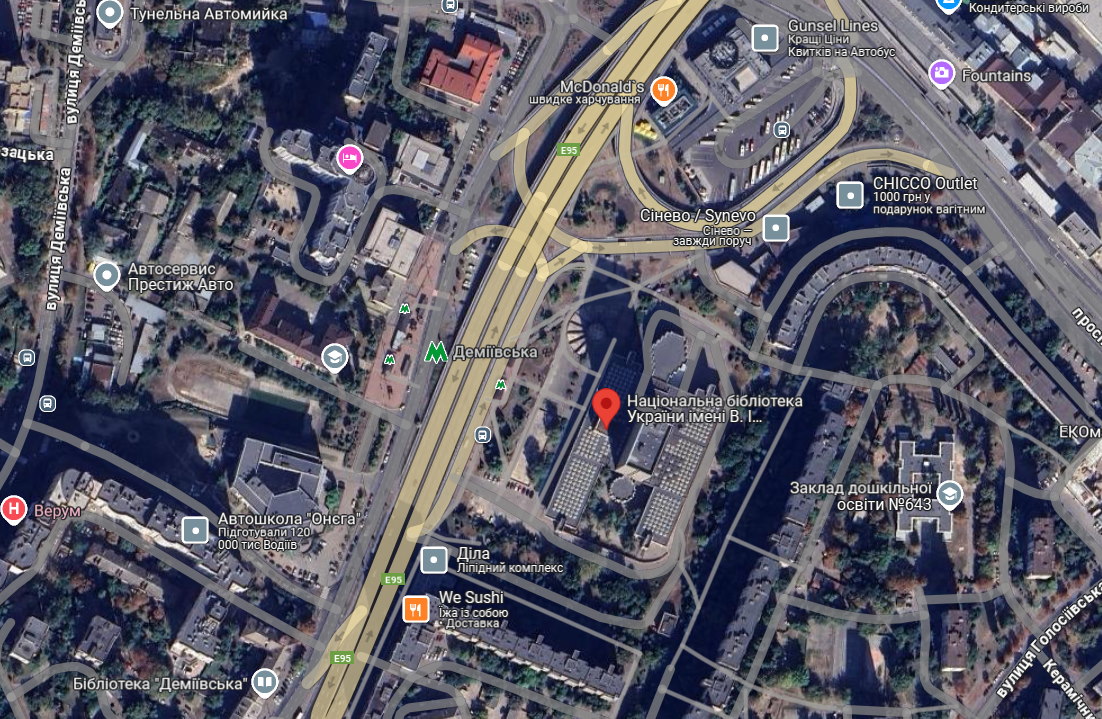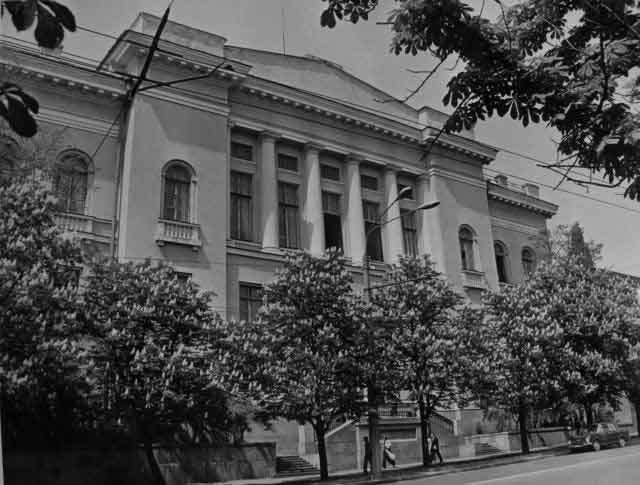In the capital, there are many places with fascinating histories that not everyone is aware of
Kyiv consists of ten administrative units—districts. Each one is the size of a small town. The districts have their own histories, traditions, and landmarks.
Kashтан NEWS shares and reminds us of interesting facts about the districts of Kyiv. In particular, it mentioned areas with names like Mysholovka, Zvirynets, Batyeva Hill, Lysa Hill, Chorna Hill, Cherepanova Hill, Korchuvate, Feofaniya, Hipodrom, “Expo Center”, the museum in Pirogovo, Teremky, Holosiivskyi Park, and Baikove Cemetery, among others.
Today, we will talk about the National Library of Ukraine named after Volodymyr Vernadsky.
Location
The National Library of Ukraine named after Volodymyr Vernadsky is the main library institution in the country. It is located in the Holosiivskyi district of Kyiv at Holosiivskyi Avenue, 3, covering an area of three hectares.
 7
7 History
The modern 27-story library building was constructed in 1989 based on a design by a group of architects from “Kyivproekt.” The library complex has a tower-like construction for the storage of books, built around a vertical transport shaft, from which horizontal layouts of reading and service rooms extend, allowing reading rooms to be situated on a single level. The total area of all premises is 35.7 thousand sq. m. The building height is 78.6 m, of which nearly two meters is attributed to the spire. The library's storage facility is designed with minimal light access to prevent the deterioration of books. Additionally, the building has two underground levels.
The institution's history began in 1918 when the concept of the National Library of the Ukrainian State was announced.
 8
8 In 1929-1930, a specialized building for the library was constructed at 62 Volodymyrska Street. This building has been preserved and is still in use today, forming a unique architectural ensemble together with the building of the Scientific Library of Taras Shevchenko National University of Kyiv.
During World War II, the library had to be evacuated to Russian Bashkortostan, specifically to the city of Ufa. It operated there in the premises of a pedagogical university until 1944, after which it returned to Kyiv.
Manuscripts do not burn
As is often the case with places that store flammable items, a fire occurred in the library on May 24, 1964. It was later revealed that it was arson committed by a library employee, Viktor Pohruzhalskyi. At the time, rumors circulated that he was a secret agent of the KGB. The perpetrator justified his actions as revenge against the library director. Interestingly, during the trial, no one raised the question of why Pohruzhalskyi, who worked in the Russian department of the library, chose to set fire to the premises containing Ukrainian publications in his act of vengeance against the director. The arson caused significant damage to the collection of domestic periodicals, primarily to Ukrainian books from the Soviet era, a certain number of foreign magazines, and part of the duplicate fund of Ukrainian literature. In total, the fire destroyed nearly 10 percent of the main library collection. However, in the following years, the losses were restored through publications from the exchange-reserve fund of other libraries in the USSR.
 9
9 By court decision, the perpetrator received a 10-year prison sentence, but he did not serve the entire term and was released early, later moving to Moldova.
It is worth noting that 150 firefighters were involved in extinguishing the fire, 10 of whom suffered from phosphorus poisoning. Experts suggest that this may indicate that Pohruzhalskyi used phosphorus grenades for the arson, which are quite difficult to extinguish immediately.
Following the fire, an additional storage facility was built, and a new literature accounting system was implemented.
Loss of Life
Another tragedy struck the library on September 29, 2010. During renovation work on the twentieth floor of the storage facility, a team of in-house electricians was working. At some point, the gas fire suppression system was activated, resulting in the death of two individuals and one being hospitalized in the toxicology department of the emergency hospital, according to reports from the State Emergency Service. There was no fire or explosion.
 0
0 Interesting Facts
In August 2018, the library celebrated its 100th anniversary. Throughout its existence, it has changed its name 12 times and has been led by 28 directors.
 1
1 Currently, the library is the largest in Ukraine by the volume of collections and area. Its collection comprises over 15.8 million storage units. The institution employs over 900 people, of whom 70% are library staff, 17% are researchers, and 13% are representatives of other specialties. Among the researchers, there are 27 doctors and 125 candidates of sciences. Nearly half a million readers utilize the library's information resources, with up to 5 million documents issued annually. The premises feature 22 specialized halls and 14 reading rooms.
The library ranks among the top twenty largest bookstores in the world and engages in international book exchange with 591 research institutions in 62 countries.
 2
2 Notably, all printed periodicals have electronic versions available on the official website of the institution. The library's archives contain the most comprehensive collection of monuments of Slavic writing from the 10th to the 12th centuries, manuscript books, and book collections of prominent figures of Ukrainian and world science and culture. Additionally, the library possesses the largest music storage facility in Ukraine, containing nearly 225 thousand units, dating back to the second half of the 17th century.
The modern structure of the library comprises over 50 subdivisions, grouped by areas of activity into research institutes.
 3
3 The library has its own electrical substation, and air conditioning systems maintain optimal temperature and humidity levels in the premises. Simultaneously, the reading rooms experience air exchange three times an hour. The checkpoint is equipped with a radio frequency system to protect book collections against unauthorized removal.
A unique architectural highlight of the building is a ramp featuring 11 busts of prominent individuals who made significant contributions to the development of Ukrainian and world science and culture.
 4
4 In the foyer before the reading rooms, visitors are greeted by the tapestry “Sources of Slavic Writing,” measuring 7 by 3.5 meters. It was hand-stitched from wool and lurex by Maria and Ivan Lytovchenko. Additionally, a monumental decorative panel titled “The Pain of the Earth,” covering an area of 300 sq. m., is located in the central vestibule.
How to Get There
If you are interested in the National Library named after Volodymyr Vernadsky and wish to visit it to see everything with your own eyes, you can take the metro to the “Demiivska” station, as well as buses on routes No. 1, 20, 22, 28, 42, 119; trolleybuses No. 11, 12, 91; minibuses No. 20, 27, 239, 416, 470, or use personal transport with a navigator.
Yevhen DEM'YANOV